List Of Ghats In Varanasi: Ghat is a term mostly used to describe the steps leading to a river. Varanasi a prominent city in Uttar Pradesh is known as the City Of Ghats. Most of these Ghats are used for purposes like Pooja ceremony or bathing, while some for the cremation process. Many of these Ghats are associated with historical legends or mythologies like Dashashwamegha, Manikarnika, and Harishchandra Ghat. Some are built by rulers like Ahilya Bai Holkar of Malwa region, Peshwa’s of Gwalior, Man Singh of Amber, Jai Singh of Jaipur, etc.
You can very easily walk through the entire length of the ghats without any interruption. But I would also recommend taking a boat ride on the Ganga to get a panoramic view of the Ghats
List Of Ghats In Varanasi: The list below takes you from the Assi Ghat in the south of the city, all the way up to Adi Keshava Ghat in the far north, beyond Malviya Bridge.
- Assi Ghat: Situated in the southernmost of Varanasi, this place is one of the biggest ghats of Varanasi and the most popular one. This place is related to two mythological stories, one of them is that Goddess Durga, threw her sword, after killing the demon Shumbha-Nishumbha. The place where the sword landed, resulted in the emergence of a river which was then called Assi. Another mythological tale reveals that Lord Shiva in his Rudra form killed 80 (Assi – eighty)) asuras in his rage at this place. Taking a dip at Assi Ghtaking a dip at thousands of other holy rivers.
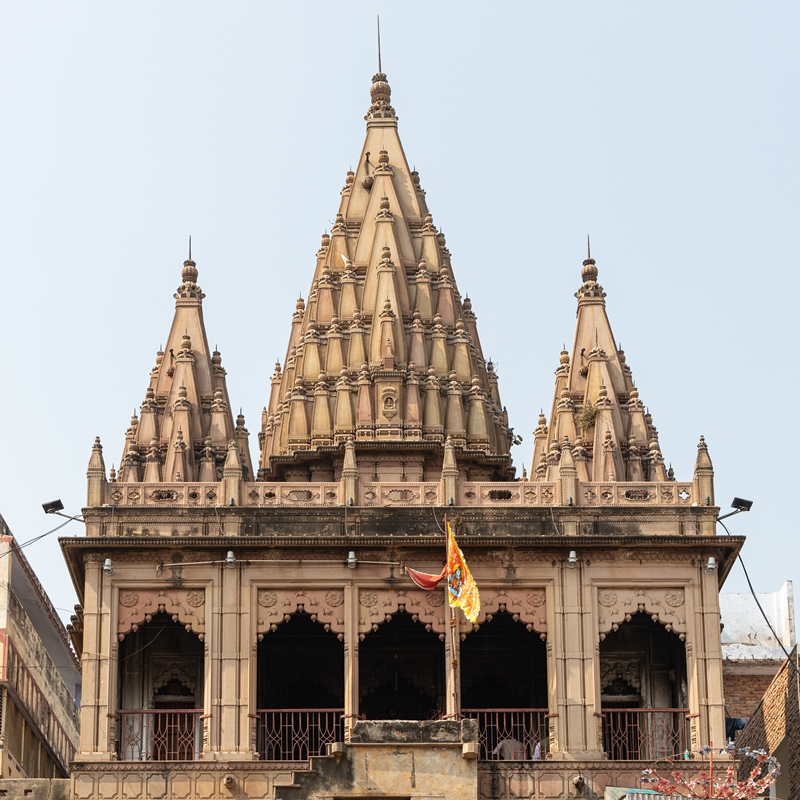
2. Ganga Mahal (I) Ghat: King of Kashi, Prabhu Narayan Singh Of the Narayana dynasty built this ghat in 1830 AD. It’s a prominent ghat in terms of being the center of cultural and religious activities.
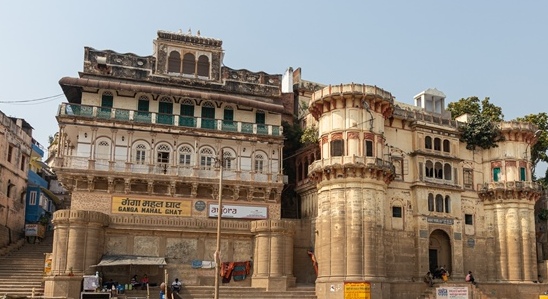
3. Riva (Reewa) Ghat: Rewan Ghat is an extension of Assi Ghat in Varanasi. Lala Mishir, the royal priest in the court of Maharaja Ranjit Singh (Punjab) constructed this ghat and named it Mishir Ghat. Maharaja Rewan purchased this ghat in 1879, after which it is known as Rewan Ghat.
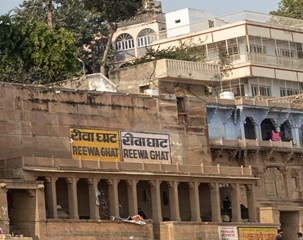
4. Tulsi Ghat: This Ghat is named after the great poet Tulsidas (1547-1622 A.D.) who wrote Ramcharitmanas, a translation of the Sanskrit epic Ramayana. Originally the ghat was known as Lolark Ghat, named after Lolark Kund.
5. Bhadaini Ghat: Bhadaini Ghat opens in the Bhadaini locality of Varanasi. This ghat has the water pumping and filtration set up of the Municipal Corporation of Varanasi. The steps of this Ghat are entirely made of bricks instead of rocky stones.

6. Janaki Ghat: This Ghat was built under the orders of the Queen of Sursand Rani Kunwar in 1870. It is believed that the people of Sursand were devotees of Goddess Sita (Janaki) and that’s why it got this name.
7. Anandamayi (Mata Anandami) Ghat: This Ghat got its name after the well-known Saint Anandmayee. She bought this place from the British to build an ashram for girls.
8. Vachcharaj Ghat: It is believed that a rich merchant of Varanasi has built this ghat in 1790 and in his memory the ghat is named Vaccharaja Ghat. It is also believed to be the birthplace of Suparshvanath, the seventh Tirthankar of the Jain tradition.
9. Jain Ghat: Initially Jain Ghat was a part of Vachchraj Ghat. But after the development, it was given a separate identity.
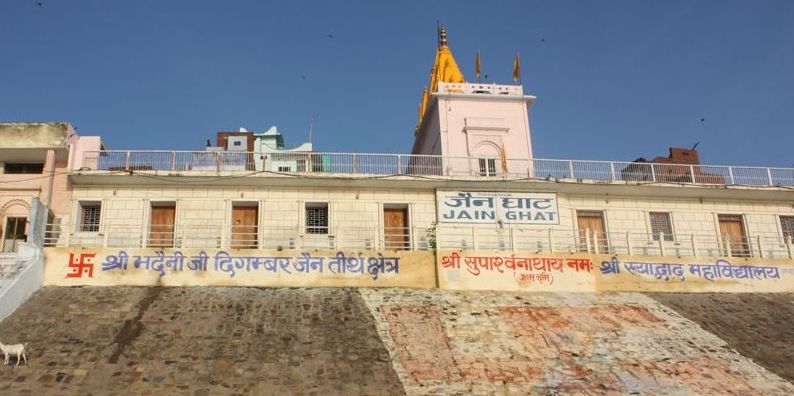
10. Nishad Ghat: Originally this ghat was a part of Prabhu Ghat until it was split in the early 20th century. The Ghat has got this named after the mythical chief of the boatmen, Kewat, who helped Ram, Sita and Lakshman cross the river in the Ramayana.
11. Prabhu Ghat: Prabhu Ghat is named after Maharaja Prabhu Narayan Singh. He ruled Banaras from 1889 to 1931 and built this in the 20th century.
12. Panchkota Ghat: Panchkota Ghat was constructed in the late 1800s by the King of Panchakota (Bengal).
13. Chet Singh Ghat: The ghat is named after the brave ruler Chet Singh, who was an illegitimate son of Balwant Singh, the first Maharaj of Banaras. Chet Singh denied providing his troops to East India Company which resulted in a fierce battle that took place at Chet Singh Ghat. He made his escape by climbing out of a window and hence the ghat was originally known as Khirki Ghat.
14. Niranjani Ghat: This Ghat is related to the Naga Sadhus, the Himalayan ascetics who established Niranjani Akhara (wrestling arena) here in 1897. Before 1897 this Ghat was originally a part of Chet Singh fort.
15. Maha Nirvani Ghat: This Ghat was named after the Mahanirvani sect of Naga Saints. It is believed that Acharya Kapil Muni of Sankhya philosophy fame lived here during the 7th century A.D.
16. Shivala Ghat: Shivala means ‘a place or shrine of Shiva’, there’s a Shiva temple on the ghat. The Ghat was built by King Balwant dedicated to Lord Shiva. The ghat was reconstructed by the Nepali King Sanjay Vikram Shah.
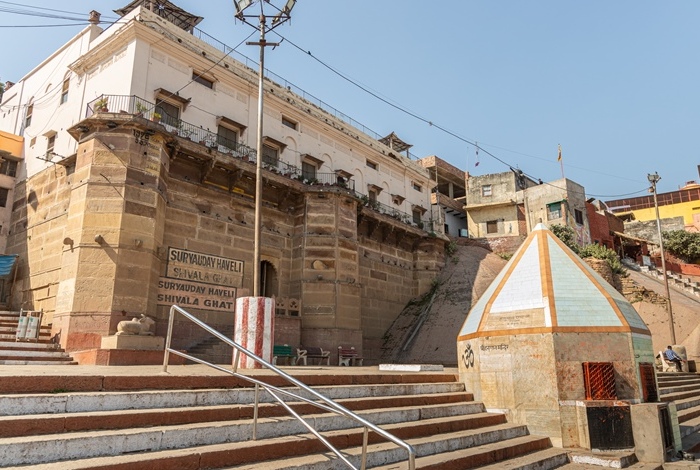
17. Gularia Ghat: Gularia Ghat has no religious significance. This Ghat was named after a huge Gular Tree that was once here.
18. Dandi Ghat: This Ghat is named after the Dandi ascetics. They are known for carrying a stick in their hand.
19. Hanuman Ghat: It is also known as Rameswaram Ghat, Hanuman Ghat is named after the temple here that was built in the 18th century by the great poet Tulsidas. It is also believed that Lord Ram built this Ghat for his favorite disciple Hanuman Ji.
20. Prachina (Old Hanuman) Ghat: Saint Vallabha laid the philosophical foundations dedicated to Krishna bhakti. This place also has a temple of Rama consisting of five Shiva Lingams named after Rama (Ramesvara), his two brothers (Laksmansevara and Bharatsvarar), his wife (Sitesvara), and his monkey-servant (Hanumadisvara).
21. Karnataka Ghat: This Ghat was built by the king of Mysore (Karnataka) in the early 20th century.
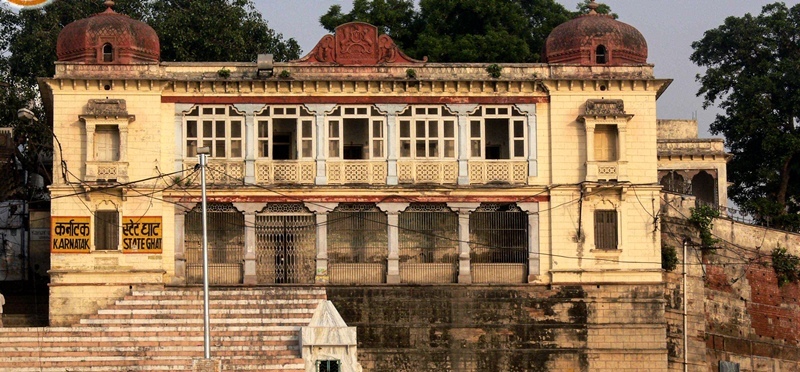
22. Harishchandra Ghat: This Ghat is dedicated to legendary King Harishchandra and is one of the two cremation ghats of the city. Harishchandra donated his entire kingdom to the sage Vishwamitra. The sage also claims “Dakshina” to be paid as a part of the donation. Since Harishchandra does not have anything left for himself, he sells his wife Taramati and son to a Brahmin family to pay for the Dakshina. Later he sells himself to the guard at the cremation ground. While working in the garden Harishchandra’s son gets bitten by a snake. Taramati takes his body to the cremation grounds where Harishchandra is working. Harishchandra does not recognize his family. Dutiful Harishchandra requests Taramati to pay the amount to finish the cremation. Since Taramati does not have anything to pay, she then offers her saree, a part of which was used to cover the dead body of her son. Harishchandra accepts the offering but before he could start the cremation, the lord Vishnu, Indra, and several Hindu deities along with the sage Vishwamitra praise Harishchandra for his determination and loyalty. They bring Harishchandra’s son back to life and offer the king and his family, instant places in heaven. Harishchandra refuses this offer as he was still bound to his master, the guard at the cremation ground. The sage Vishwamitra then reveals that the guard is Yamaraj (the god of death in Hinduism) and Yamaraj allows Harishchandra to accept the offer.
23. Lali Ghat: According to Folk Legends, this name of the Ghat was given after a famous saint Lali Baba of Champaran (Bihar).
24. Vijaynagram Ghat: This Ghat was built by Pusapati Narayana Gajapathi Raju, Maharaj of Vijaynagar in the 1800s.
25. Kedar Ghat: The Kedar Ghat has great mythological importance. It is believed that anyone who visits Kedareswara Shiva Temple, gets blessings as the same after visiting Kedarnath Temple.
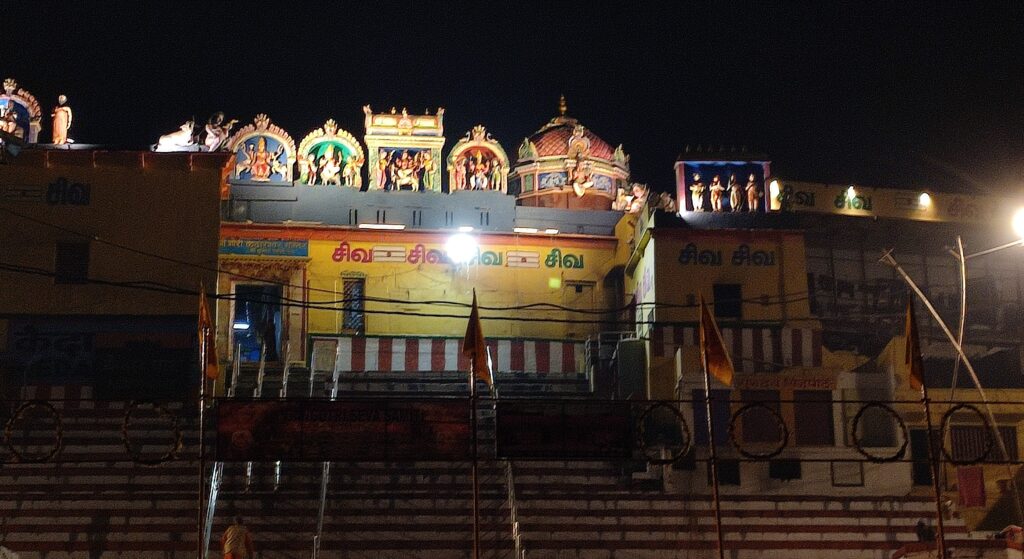
26.Chauki Ghat: Chauki Ghat, got its name from its characteristics of crossroads divergence of 4 lanes. One lane diverges to Kedareshwara, the second one diverges to Mansarovar, the third one diverges to Sonarpura, and the last one diverges to the steps of the Ghat.
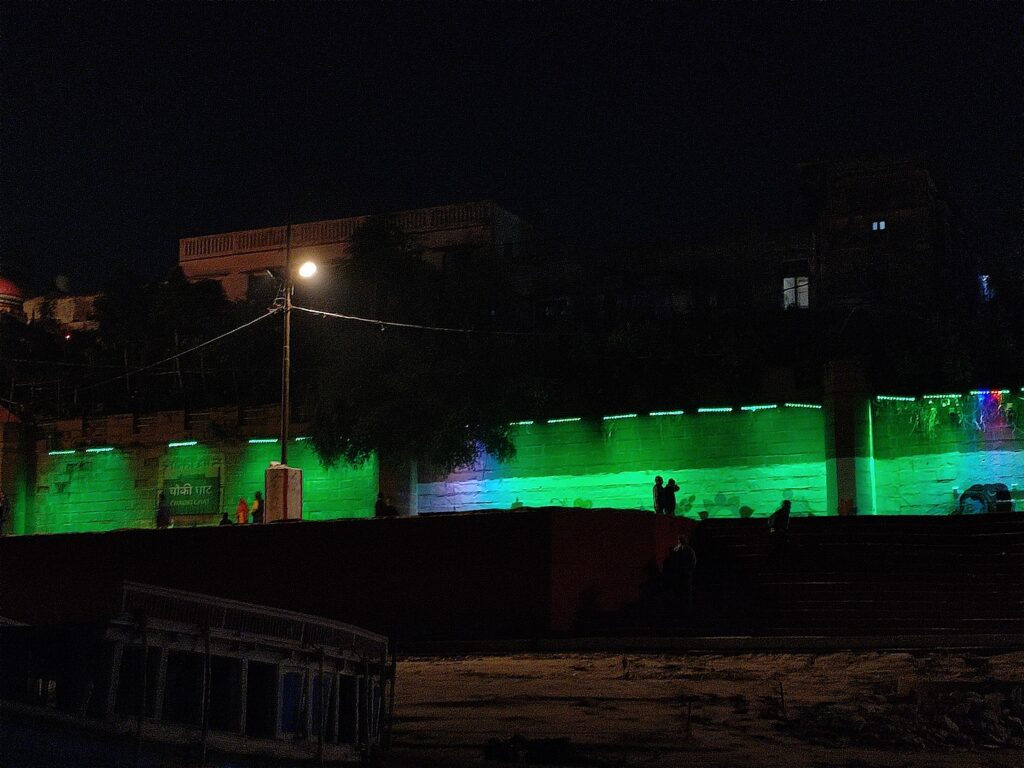
27. Ksemesvara (Somesvara) Ghat: This Ghat is dominated by Bengali residents. Earlier it was known as Nala Ghat.
28. Mansarovar Ghat: Mansarovar Ghat was built by Raja Man Singh, King Of Amer in 1585, alongside is the Mansarovar Kund and it is believed that taking a bath her is as pious as taking a dip in Mansarovar lake of Himalayas.
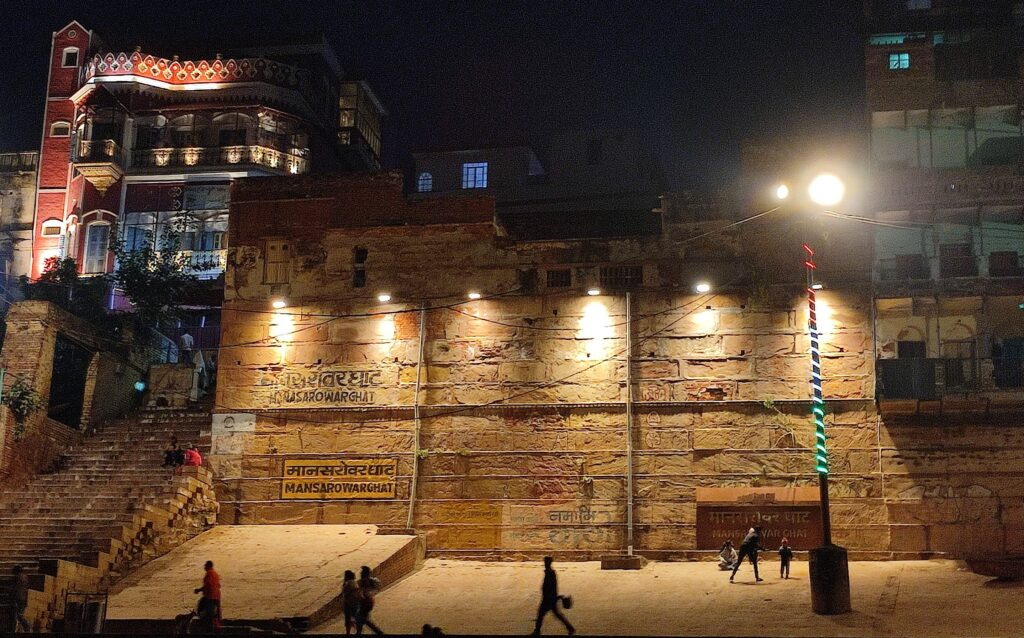
29. Narad Ghat: Narad Ghat is named after the sage of Hindu Mythology, Narad. He was considered as the messenger between all the Loks (Swarg, Paatal, Dharti). Bathing here is prohibited for couples, as it is believed that it may create problems in future lives and their married life. Probably as Narad was a Bramhachari.
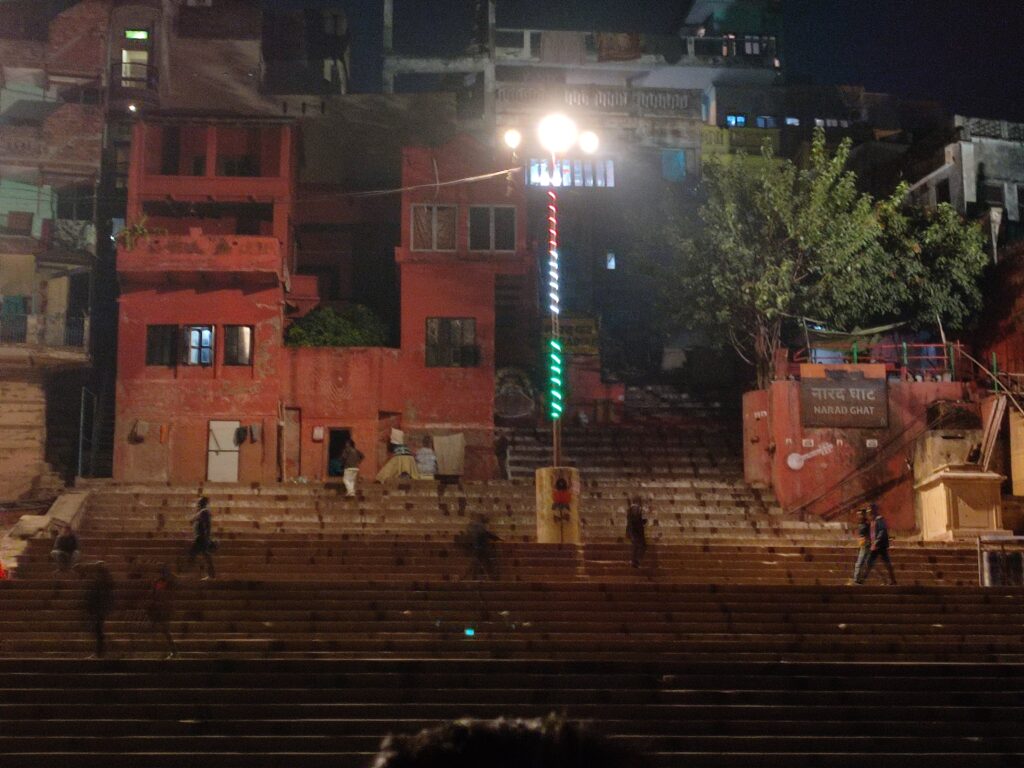
30. Raja Ghat: It was initially built in 1720 and was known as Amrit Rao Ghat. Amrit Rao Peshwa rebuilt this Ghat between his exile to Varanasi.
31. Khori Ghat: This Ghat doesn’t have much significance.
32. Pandey Ghat: Pandey Ghat was named after Babua Pandey, a renowned wrestler of Bihar.
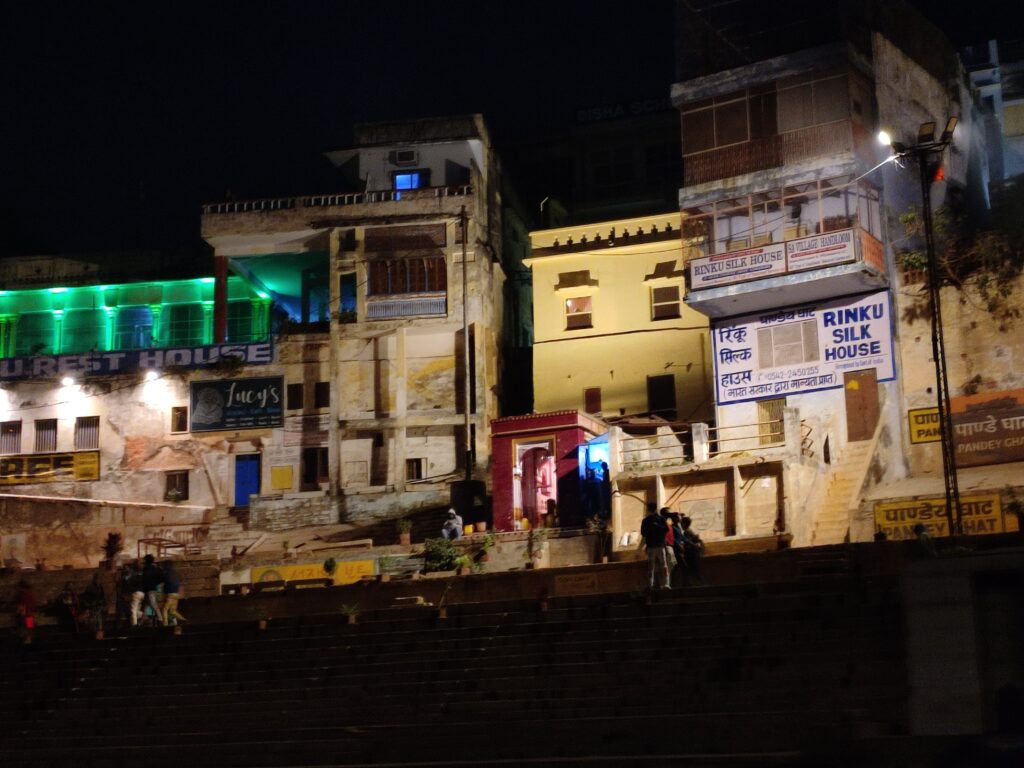
33. Sarvesvara Ghat: It was a part of Pandey Ghat, named after the Sarveshwara temple residing there.
34. Digpatiya Ghat: This Ghat was built by the king Digpati Of Bengal in 1830. He had built a temple, palace, and also residence. Yogini temple holds a great significance here.
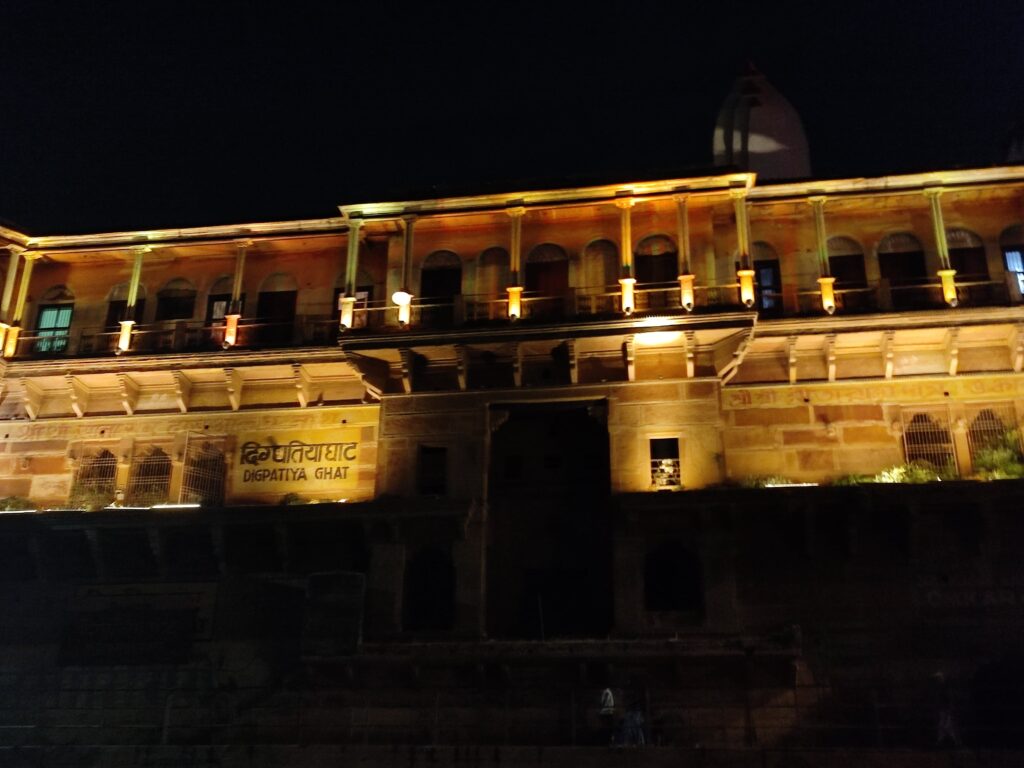
35. Chausathi Ghat: This Ghat got its name from the number 64 as it enshrines 64 statues of Yoginis and is the lady mate of Maa Kali.
36. Rana Mahal Ghat: Built by Maharana of Udaipur in 1670.
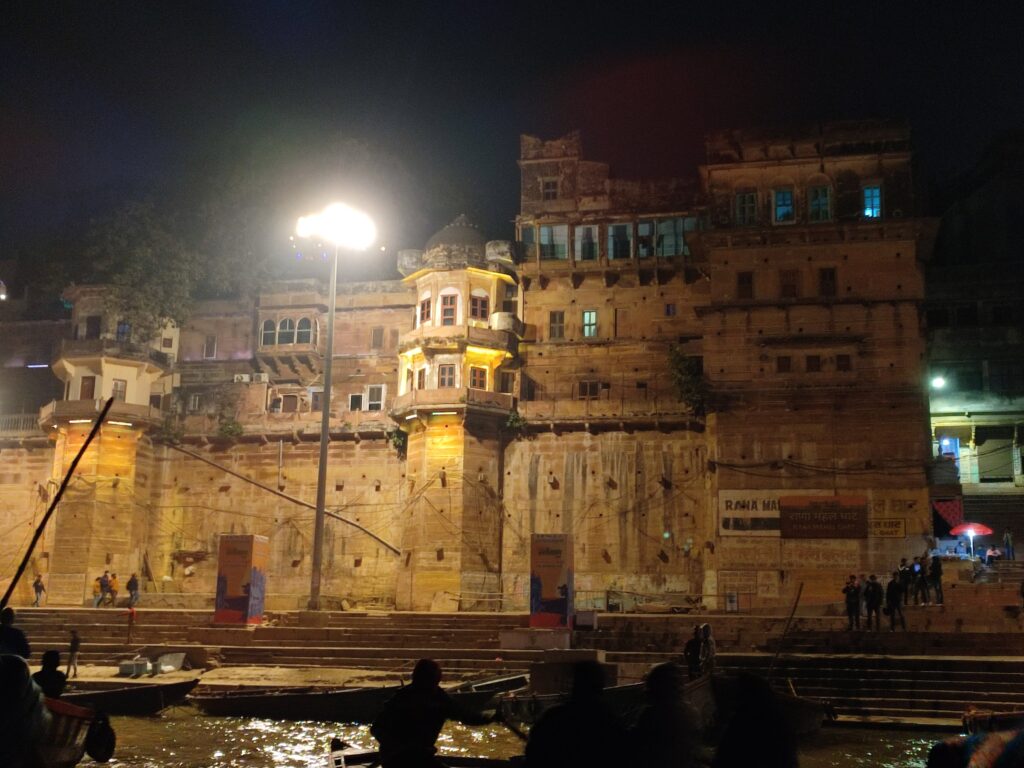
37. Darbhanga Ghat: Darbhanga Ghat was built by the king of Darbhanga. The royal family also built a magnificent palace in the 1900s.
38. Munshi Ghat: This Ghat is named after the finance minister of Nagpur, Sridhara Narayana Munshi. Clarks Hotel Group has purchased this place to build a 5-star hotel.
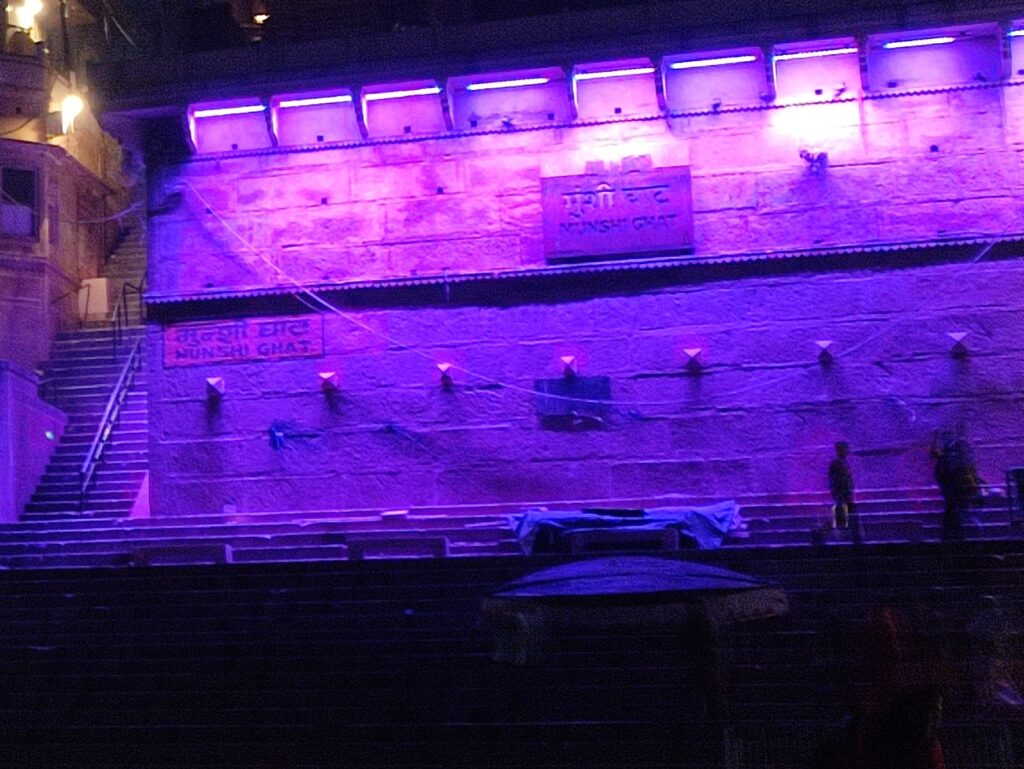
39. Ahilyabai Ghat: This Ghat was formerly known as kevalagiri Ghat and was rebuilt by Maharani Ahilyabai of Indore. She was a great pioneer and built more than hundreds of temples and dharmshala in India.
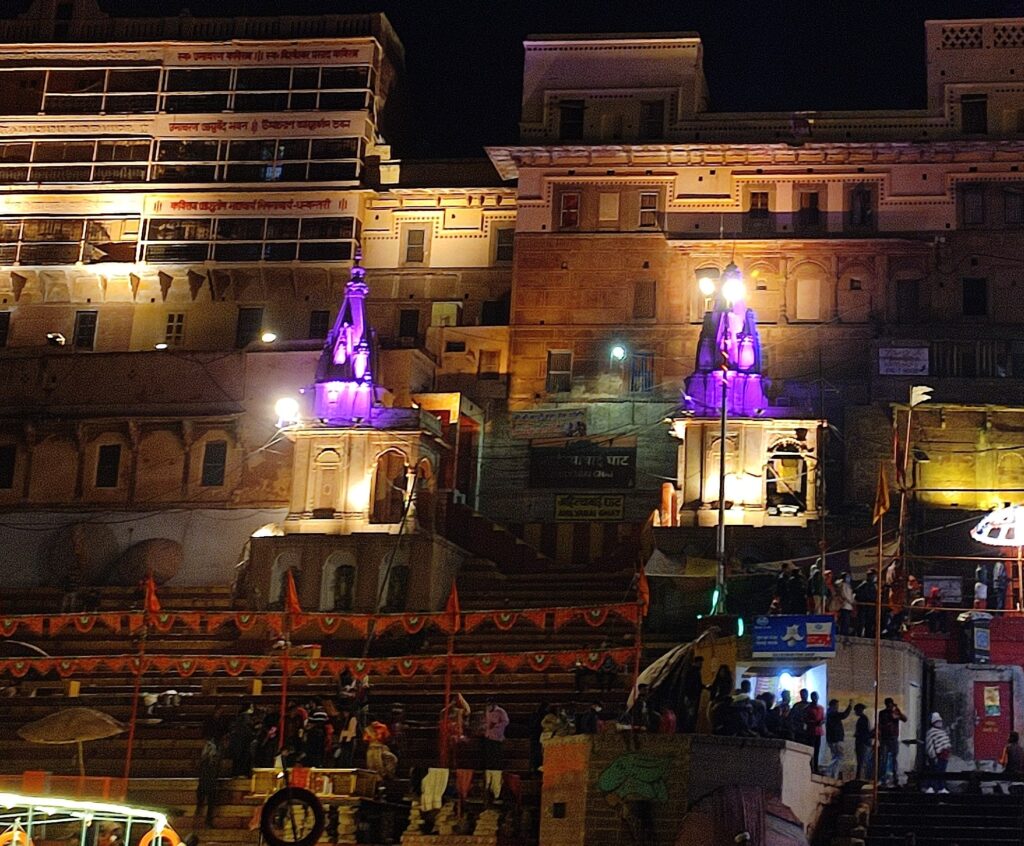
40. Shitala Ghat: Named after the Shitala Temple built over there.
41. Dashashwamedh Ghat: This Ghat is probably the busiest in Varanasi and is often referred to as the main Ghat. This Ghat is famous for its Ganga Arti that takes place every morning and evening. There are two stories related to it, one is that Lord Bramha created this Ghat to welcome Lord Shiva on Earth, while other texts say that Lord Bramha performed Dashashwamedh Yajna (sacrifice of 10 horses) here.
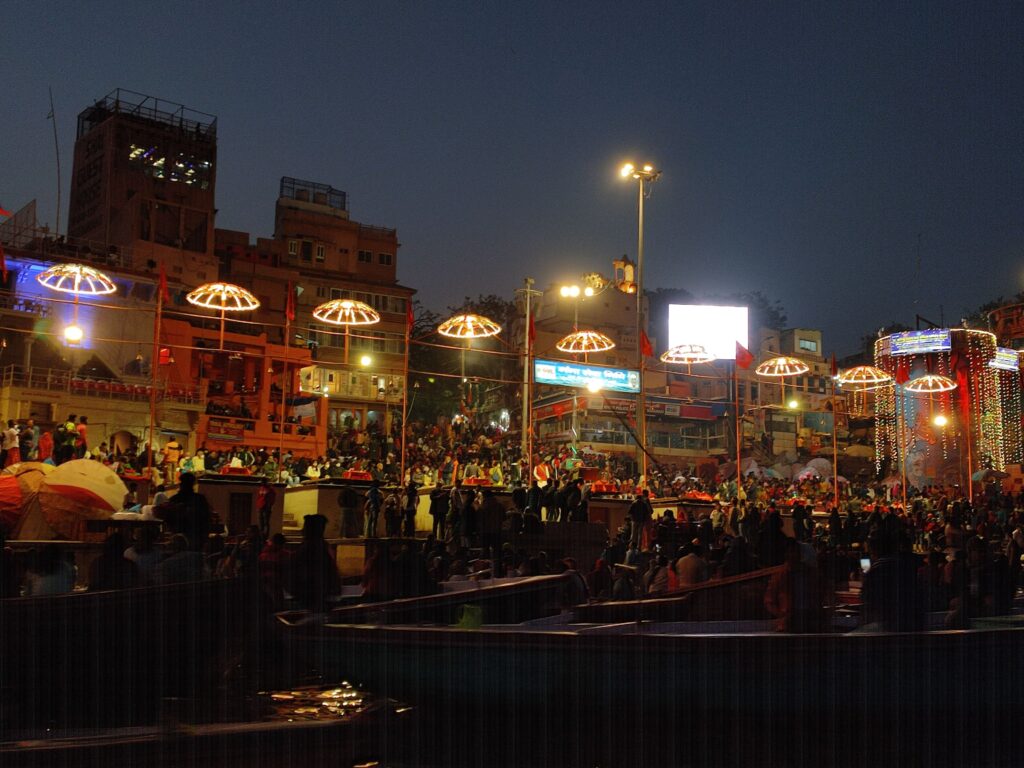
42. Prayag Ghat: Prayag Ghat is always overcrowded with devotees who come to offer prayers here. This Ghat represents Prayagraj (Allahabad) which is another holy city in Uttar Pradesh. It was renovated by the queen of Bengal.
43. Rajendra Prasad Ghat: Formerly this Ghat was known as Ghoda Ghat as this Ghat had witnessed ten horse sacrifices. Later in 1979, it was renamed Rajendra Prasad Ghat in memory of Dr. Rajendra Prasad, president of India.
44. Man Mandir Ghat: This Ghat was known as Someshwara Ghat until the 16th century. Raja Man Singh of Amer built a magnificent palace over there and named it after him.
45. Tripurabhairavi Ghat: Named after Tripura Bhairavi, Goddess of the cosmic universe.
46. Mira Ghat: It was named after famous tax collector Mira Rustom Ali.
47.Phuta Ghat: This was earlier known as Yajneswara Ghat.
48.Nepali Ghat: It was built by the king of Gorkhas in the early 20th century. This area is dominated by Nepalese residents.
49.Lalita Ghat: This Ghat is built by the king of Nepal. It is a shrine to two temples i.e, Lalita Gauri Mandir and Nepali Temple. Goddess Lalita is one of Dasha Mahavidyas.

50. Bauli Ghat: Residents say that this ghat was built by a rich merchant of Varanasi
51. Jalashayi Ghat: According to mythologies it is believed that Lord shiva slept deep under this ghat. A ritual of putting the corpse into the water before cremation is followed here.
52. Khirki Ghat
53. Manikarnika Ghat: It is one of the prominent Ghat in Varanasi. It is believed that people who get cremated here attains moksha. There are various stories related to this ghat. The first one is, when Adi Shakti jumped into the fire in anger, Lord Shiva carried her burning body to the Himalayas. Seeing this pain, Lord Vishnu sent his divine chakra to cut her body into pieces. These pieces fall on earth as shakti peeths. It is believed that her earring fall here. The second tale says that the earring of Lord Shiva fell here while he was performing Tandava in Rudra form. Lastly, it is also said that Lord Vishnu invited Lord Shiva and Goddess Parvati on earth and created a kund (well) for the couple to bathe. When Lord Shiva was taking a bath his earring fell here.

54. Bajirao Ghat: This ghat was constructed by Peshwa Bajirao Of Maharashtra.
55. Scindia Ghat: This Ghat is named after Scindia who built it in the 1830s. Tilted Lord Shiv Temple, named as Ratneshwar Temple makes it uniques from the rest of the ghats. It is believed that this temple was cursed by a mother. One of the tales says that this temple was built by a son for his mother Ratna Bai, he then boasted he paid all the debts to his mother. However, the debts to a mother can’t be repaid. The temple started leaning because of the curse. According to Another tale, Ratna Bai servant of Ahilya Bai built this temple. But Ahilya Bai cursed it to lean and would not be worshipped by anyone as the servant had named it after herself.
56. Sankata Ghat: This got its name after the Sankata Temple that was built on the top. It is believed that Pandavas had worshipped Goddess Sankata over here during their exile.
57. Ganga Mahal (II) Ghat: This Ghat is known for its majestic look. legends say that a bath here can help you to get rid of Yama dosh.
58. Bhonsale Ghat: King Bhonsale of Nagpur built this ghat. It is a shrine to the Yameshwara temple and Yamaditya Temple.
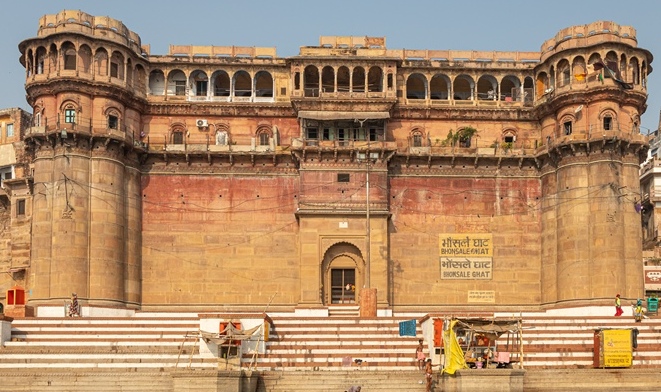
59. Naya Ghat: Believed to be built by the King of Peshwa. It was earlier known as Gularia Ghat.
60. Ganesh Ghat: Named after Ganesh temple constructed over here.
61. Mehta Ghat: Earlier this was a part of the Ganesh Ghat. But was given a separate identity after V.S Mehta Hospitals.
62. Ram Ghat: This Ghat is dedicated to Lord Rama.
63. Jatara Ghat: This ghat was built by Balaji Cimadi Jatar, a finance secretary of Gwalior.
64. Gwalior Ghat: Built by Jayajirao Shinde, King of Gwalior.
65. Mangala Gauri Ghat: This ghat was built by the Peshwas, but was rebuilt by Laxmana Bala of Gwalior. And hence it is also known as Bala Ghat or Laxmana Ghat.
66. Venimadhava Ghat: This ghat is a part of Panchganga Ghat. This ghat is a shrine to Bindu Madhava Temple which was destructed by Aurangazenmb to build Alamgiri Mosque.
67. Panchganga Ghat: It is believed that five pious rivers converged here, that are Ganga, Yamuna, Sarawati, Kirana, Dhipapapa. Out of these rivers only Ganga is visible.
68. Durga Ghat: This Ghat got its name after the Goddess Durga Temple that was built on the top.
69. Brahma Ghat: It is believed that Lord Bramha settled over this ghat. This ghat along with Durga Ghat was rebuilt by Narayani Dixit.
70. Bundi Parakota Ghat: This Ghat was built by the King of Bundi. This ghat is famous for amazing wall paintings on the ghat.
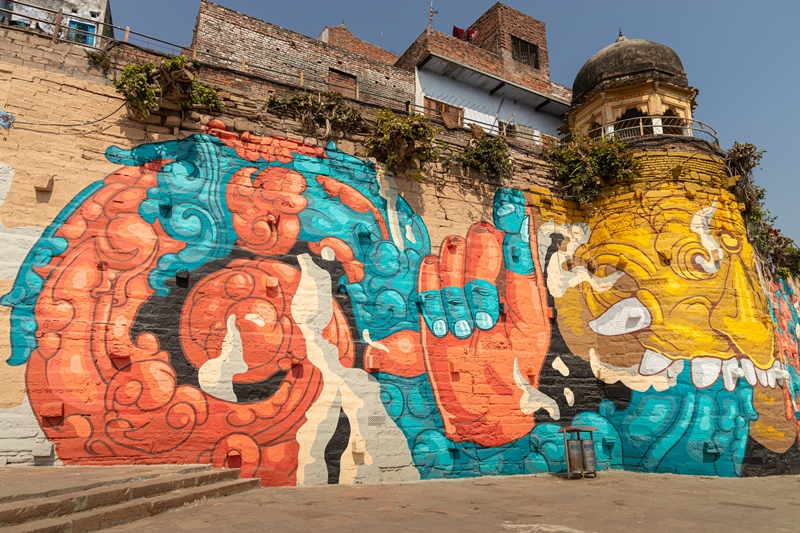
71. Adi Sitala Ghat: This Ghat was an extended part of the above-mentioned ghat.
72. Lal Ghat: This ghat was constructed by a rich merchant of Varanasi and was named after him.
73. Hanuman Garhi Ghat: This ghat represents the Hanuman Garhi site of Ayodhya. It was built by Shyam Lal Mahatyagi.
74. Gai/ Gaay Ghat: Gaay ghat is named after the iconic statue of Nandi. Gaay means cow in English.

75. Badri Narayan Ghat: It got its name from the Badrinath temple built there, which is a replica of the Badrinath temple of Uttarakhand.
76. Trilochan Ghat: Trilochan ghat derived its name from Trilochaneshwar Temple, located there. Trilochan means three-eyed Shiva.
77. Gola Ghat: This ghat is one of the ancient ghats of Varanasi and was the busiest ferry point.
78. Nandeshwara Ghat: Commonly referred to as Nandu Ghat, is named after Nandeshwara Shiva Temple. Most of the Bollywood shootings take place here, like Ranjhana.
79. Sakka Ghat
80. Telianala Ghat: It is assumed that the name of the ghat was named so because of the oil-pressing communities residing her.
81. Naya/Phuta Ghat: Phuta Ghat got its name after the phuteshwara shiva temple. After the renovation of this place, it was named Naya (new) ghat.
82. Prahlad Ghat: It is an ancient pilgrimage site named after Prahlad, son of Hiranyakashyap. Prahlad was known for his devotion to Lord Vishnu
83.Nishad Ghat: This ghat is named after the nishad community, who are indulge in river centric occupations
84. Rani Ghat: This Ghat holds no religious importance. Muniya Sahiba, Queen of Lucknow built this ghat.
85.Bhaisasur/ Rajghat: This ghat was a shrine to the great kings of Varanasi and hence it is named Rajghat. It is also known as Bhaisasur/ Mahishasur Ghat due to the shrine of the demon Mahishasur in front of the Ghat.
86. Adi Keshava Ghat: This ghat is considered to be the oldest Ghat of Varanasi. Lord Vishnu landed his first step over here.
87. Saint Ravidas Ghat: Situated at the southernmost in Varanasi. It is named after saint Ravidas, an Indian poet.
There are more than 85 Ghats here, a boat ride or a walk to these Ghats will surely help you to know the culture, background, and history of different places in India.
For more images check https://www.instagram.com/explorebug_/

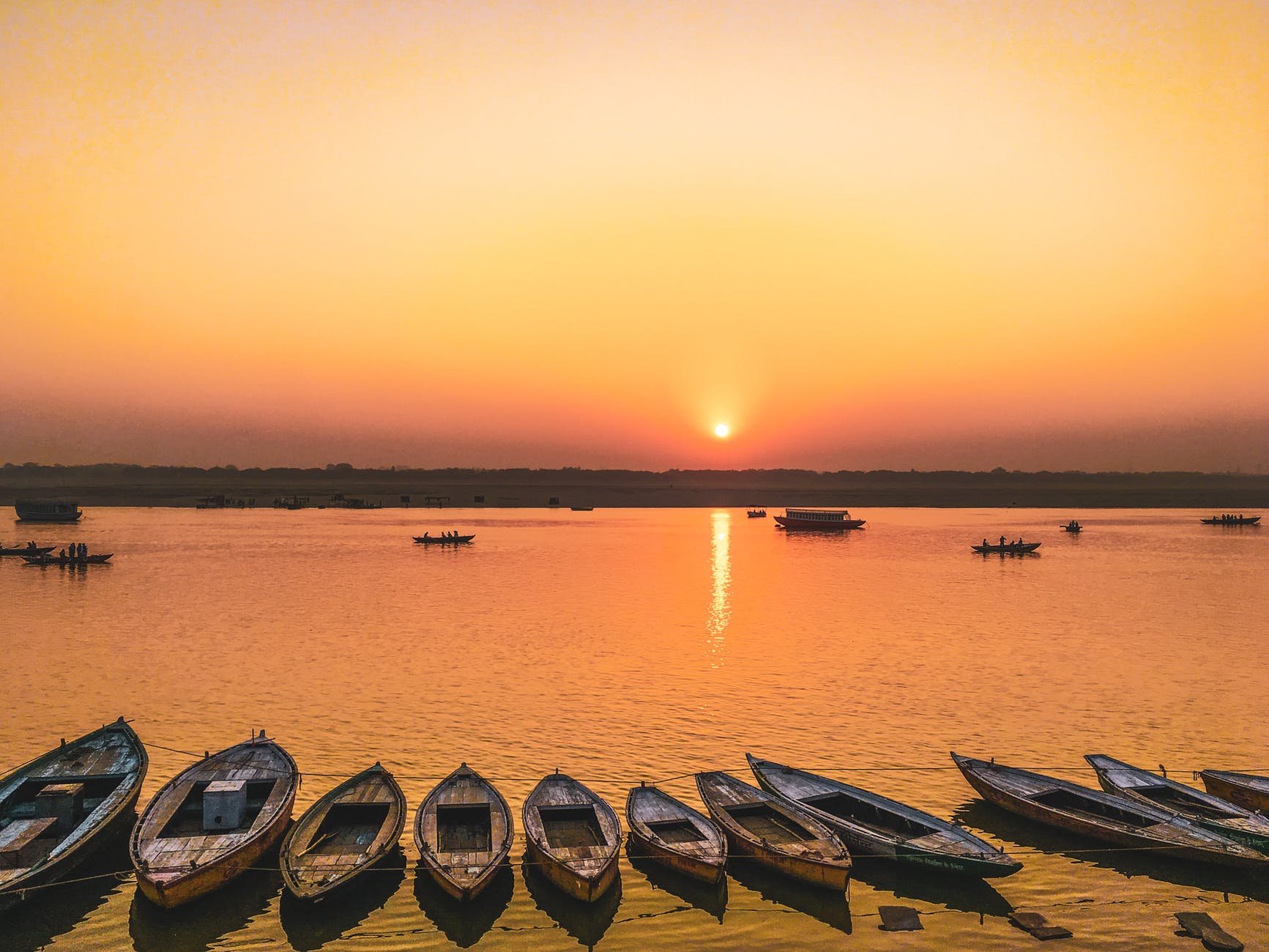
Really informative.. great work! ❤️?
Awesome pictures,,, superb information .. really loved it.. waiting for some other fantastic vlogs
Hey would you mind stating which blog platform you’re using? I’m looking to start my own blog soon but I’m having a difficult time deciding between BlogEngine/Wordpress/B2evolution and Drupal. The reason I ask is because your design seems different then most blogs and I’m looking for something unique. P.S Sorry for getting off-topic but I had to ask!
I use word press for posting my blogs?
Very nice post. I just stumbled upon your weblog and wanted to say that I’ve really enjoyed browsing your blog posts. After all I抣l be subscribing in your rss feed and I hope you write again soon!
Pingback:hetal
Excellent post! We will be linking to this great post on our website. Keep up the great writing.
Good day! I just wish to give you a huge thumbs up for your excellent information you have got here on this post. I am coming back to your blog for more soon. Good day! I just wish to give you a huge thumbs up for your excellent information you have got here on this post. I am coming back to your blog for more soon. נערות ליווי ברמלה